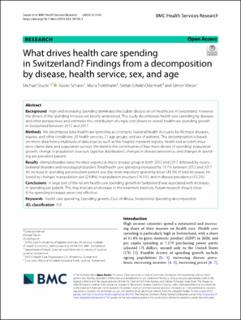Please use this identifier to cite or link to this item:
https://doi.org/10.21256/zhaw-29778Full metadata record
| DC Field | Value | Language |
|---|---|---|
| dc.contributor.author | Stucki, Michael | - |
| dc.contributor.author | Schärer, Xavier | - |
| dc.contributor.author | Trottmann, Maria | - |
| dc.contributor.author | Scholz-Odermatt, Stefan | - |
| dc.contributor.author | Wieser, Simon | - |
| dc.date.accessioned | 2024-02-02T11:02:12Z | - |
| dc.date.available | 2024-02-02T11:02:12Z | - |
| dc.date.issued | 2023-10-25 | - |
| dc.identifier.issn | 1472-6963 | de_CH |
| dc.identifier.uri | https://digitalcollection.zhaw.ch/handle/11475/29778 | - |
| dc.description.abstract | Background: High and increasing spending dominates the public discussion on healthcare in Switzerland. However, the drivers of the spending increase are poorly understood. This study decomposes health care spending by diseases and other perspectives and estimates the contribution of single cost drivers to overall healthcare spending growth in Switzerland between 2012 and 2017. Methods: We decompose total healthcare spending according to National Health Accounts by 48 major diseases, injuries, and other conditions, 20 health services, 21 age groups, and sex of patients. This decomposition is based on micro-data from a multitude of data sources such as the hospital inpatient registry, health and accident insurance claims data, and population surveys. We identify the contribution of four main drivers of spending: population growth, change in population structure (age/sex distribution), changes in disease prevalence, and changes in spending per prevalent patient. Results: Mental disorders were the most expensive major disease group in both 2012 and 2017, followed by musculoskeletal disorders and neurological disorders. Total health care spending increased by 19.7% between 2012 and 2017. An increase in spending per prevalent patient was the most important spending driver (43.5% of total increase), followed by changes in population size (29.8%), in population structure (14.5%), and in disease prevalence (12.2%). Conclusions: A large part of the recent health care spending growth in Switzerland was associated with increases in spending per patient. This may indicate an increase in the treatment intensity. Future research should show if the spending increases were cost-effective. | de_CH |
| dc.language.iso | en | de_CH |
| dc.publisher | BioMed Central | de_CH |
| dc.relation.ispartof | BMC Health Services Research | de_CH |
| dc.rights | https://creativecommons.org/licenses/by/4.0/ | de_CH |
| dc.subject | Health care spending | de_CH |
| dc.subject | Spending growth | de_CH |
| dc.subject | Cost-of-illness | de_CH |
| dc.subject | Switzerland | de_CH |
| dc.subject | Spending decomposition | de_CH |
| dc.subject.ddc | 362.1041: Gesundheitsökonomie | de_CH |
| dc.title | What drives health care spending in Switzerland? : findings from a decomposition by disease, health service, sex, and age | de_CH |
| dc.type | Beitrag in wissenschaftlicher Zeitschrift | de_CH |
| dcterms.type | Text | de_CH |
| zhaw.departement | School of Management and Law | de_CH |
| zhaw.organisationalunit | Winterthurer Institut für Gesundheitsökonomie (WIG) | de_CH |
| dc.identifier.doi | 10.1186/s12913-023-10124-3 | de_CH |
| dc.identifier.doi | 10.21256/zhaw-29778 | - |
| zhaw.funding.eu | No | de_CH |
| zhaw.issue | 1149 | de_CH |
| zhaw.originated.zhaw | Yes | de_CH |
| zhaw.publication.status | publishedVersion | de_CH |
| zhaw.volume | 23 | de_CH |
| zhaw.publication.review | Peer review (Publikation) | de_CH |
| zhaw.author.additional | No | de_CH |
| zhaw.display.portrait | Yes | de_CH |
| zhaw.monitoring.costperiod | 2023 | de_CH |
| Appears in collections: | Publikationen School of Management and Law | |
Files in This Item:
| File | Description | Size | Format | |
|---|---|---|---|---|
| 2023_Stucki-etal_What-drives-health-care-spending-in-Switzerland_BMC.pdf | 2.44 MB | Adobe PDF |  View/Open |
Show simple item record
Stucki, M., Schärer, X., Trottmann, M., Scholz-Odermatt, S., & Wieser, S. (2023). What drives health care spending in Switzerland? : findings from a decomposition by disease, health service, sex, and age. BMC Health Services Research, 23(1149). https://doi.org/10.1186/s12913-023-10124-3
Stucki, M. et al. (2023) ‘What drives health care spending in Switzerland? : findings from a decomposition by disease, health service, sex, and age’, BMC Health Services Research, 23(1149). Available at: https://doi.org/10.1186/s12913-023-10124-3.
M. Stucki, X. Schärer, M. Trottmann, S. Scholz-Odermatt, and S. Wieser, “What drives health care spending in Switzerland? : findings from a decomposition by disease, health service, sex, and age,” BMC Health Services Research, vol. 23, no. 1149, Oct. 2023, doi: 10.1186/s12913-023-10124-3.
STUCKI, Michael, Xavier SCHÄRER, Maria TROTTMANN, Stefan SCHOLZ-ODERMATT und Simon WIESER, 2023. What drives health care spending in Switzerland? : findings from a decomposition by disease, health service, sex, and age. BMC Health Services Research. 25 Oktober 2023. Bd. 23, Nr. 1149. DOI 10.1186/s12913-023-10124-3
Stucki, Michael, Xavier Schärer, Maria Trottmann, Stefan Scholz-Odermatt, and Simon Wieser. 2023. “What Drives Health Care Spending in Switzerland? : Findings from a Decomposition by Disease, Health Service, Sex, and Age.” BMC Health Services Research 23 (1149). https://doi.org/10.1186/s12913-023-10124-3.
Stucki, Michael, et al. “What Drives Health Care Spending in Switzerland? : Findings from a Decomposition by Disease, Health Service, Sex, and Age.” BMC Health Services Research, vol. 23, no. 1149, Oct. 2023, https://doi.org/10.1186/s12913-023-10124-3.
Items in DSpace are protected by copyright, with all rights reserved, unless otherwise indicated.